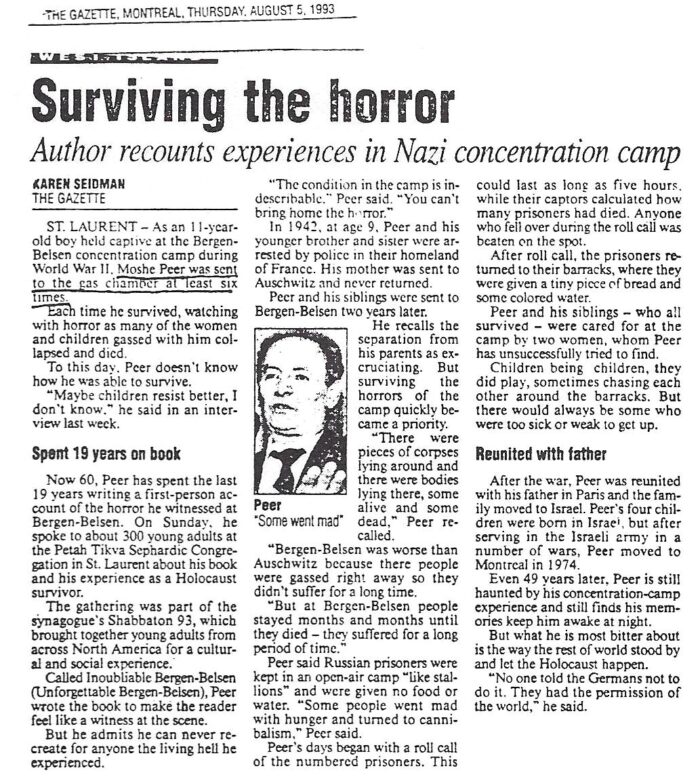Peer, Moshe
Moshe Peer was a French Jew who, at the age of 9, was arrested and, together with his family and many other Jews from France, deported to Auschwitz. While his mother perished there, he and the rest of his family were transferred to the Bergen-Belsen Camp toward the end of the war, where they all survived. In an interview published on 5 August 1993 in the Montreal newspaper The Gazette, Peer declared that as a boy he survived no fewer than six (!) gassings in the gas chamber of the Bergen-Belsen Camp:
“As an 11-year-old boy held captive at the Bergen-Belsen concentration camp during World War II, Moshe Peer was sent to the gas chamber at least six times. Each time he survived, watching with horror as many of the women and children gassed with him collapsed and died. To this day, Peer doesn’t know how he was able to survive.
‘Maybe children resist better, I don’t know,’ he said in an interview last week,”
The reason why he survived the gassings is very simple: No homicidal gas chamber ever existed at the Bergen-Belsen Camp, and no historian has ever claimed otherwise. Peer made it all up, all six of the alleged gassings.
Peer also claimed about the Bergen-Belsen Camp:
“‘There were pieces of corpses lying around and there were bodies lying there, some alive and some dead,’ Peer recalls.”
It is true that, during the final months of the Bergen-Belsen Camp’s existence, dead and dying inmates were lying around everywhere as a result of a typhus epidemic that had gotten completely out of control due to Allied bombing raids having destroyed Germany’s infrastructure. This made it impossible to supply anything to the camps or anywhere else, for that matter: food and water, medicine for the sick, fuel for the cremation furnace. But Peer’s claim that “pieces of corpses” were lying around is pushing it too far. No one was dismembering corpses there.
Peer is a typical example of a witness undermining the entire orthodox narrative by demonstrating the fraudulent anecdotal nature it rests upon. The truth is hidden in the undeniable facts: Moshe Peer was nine when he arrived at Auschwitz, together with “his younger brother and sister,” so they were not older than eight and seven, respectively. Clearly, if small children were sent to the gas chambers immediately upon arrival at Auschwitz, as the orthodox narrative wants us to believe, then these three children wouldn’t have survived one day in that camp. But as we see, they all survived, and Auschwitz wasn’t even the worst part of their experience, as he himself said: “Bergen-Belsen was worse than Auschwitz.” Since he arrived at Bergen-Belsen during that camp’s nightmarish final months, his statement is absolutely true, but it has nothing to do with homicidal gas chambers. Had there been such gas chambers in operation at Auschwitz, this article would never have been written, because Peer would not have survived his time at Auschwitz to tell his lies after the war.


You need to be a registered user, logged into your account, and your comment must comply with our Acceptable Use Policy, for your comment to get published. (Click here to log in or register.)